Ever wondered what it feels like to stand inside a 2,000-year-old prayer hall carved straight into a mountain? At Bedse Caves in Maharashtra, you can do exactly that. Unlike their famous neighbors Karla and Bhaja, these ancient Buddhist caves offer something special: intricate pillar carvings and a peaceful atmosphere away from the crowds.
This complete guide covers everything you need to know about visiting Bedse Caves, from its fascinating history to practical tips that will make your trip memorable. Whether you’re a history enthusiast, architecture lover, or weekend adventurer, you’ll find the essential information to plan your perfect visit.
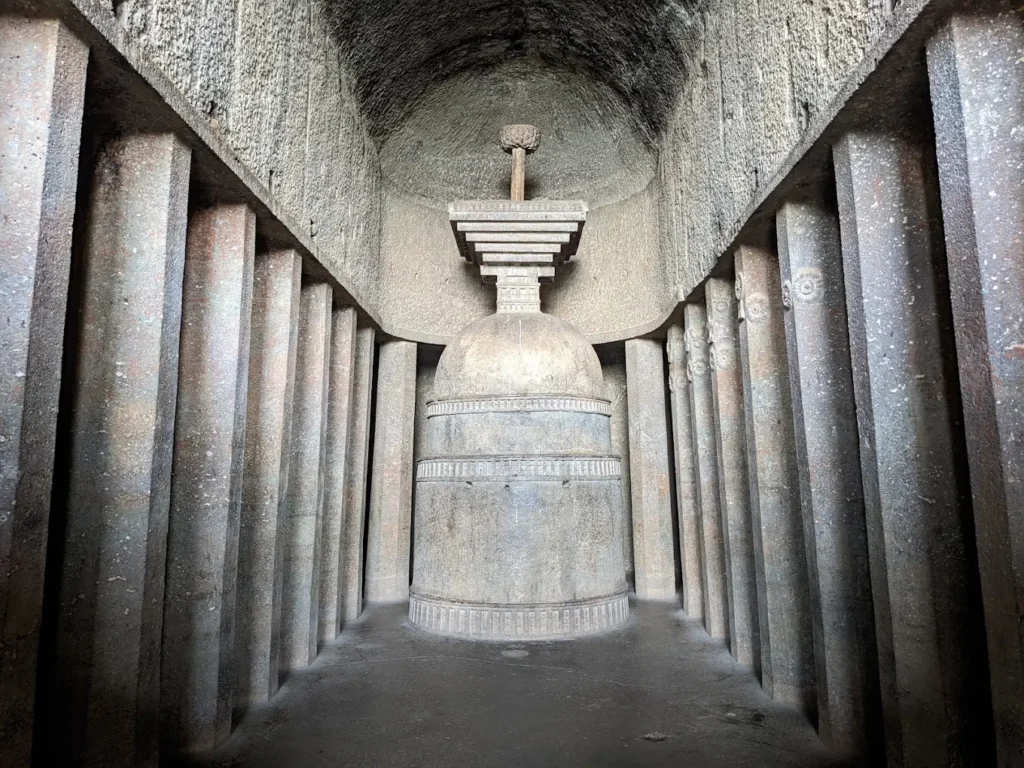
Quick Facts About Bedse Caves
Location: Near Kamshet, Pune District, Maharashtra
Built: Around 1st Century BCE
Known For: Grand Chaitya (Prayer Hall) & Vihara (Monastery)
Best Time to Visit: Monsoon & Winter (June to February)
Trek Difficulty: Easy to Moderate (approximately 400 steps)
Entry Fee: Free entry (Check ASI official website for latest updates)
Timings: Sunrise to sunset (Verify current timings here)
Distance from Pune: 60 km
Distance from Mumbai: 120 km
Planning Your Visit to Bedse Caves
How to Reach Bedse Caves
From Pune (60 km, 1.5 hours): Take the Mumbai-Pune Expressway and exit at Kamshet. From Kamshet, follow the road toward Bedse village. The last 2 km involves a narrow village road, so drive carefully. Park at the base of the hill near the village and begin your climb.
From Mumbai (120 km, 2.5 hours): Take the Mumbai-Pune Expressway toward Pune. Exit at Kamshet and follow the same route as mentioned above. Early morning departure is recommended to avoid expressway traffic.
Transport Options:
By Car: Most convenient option. The road to Bedse village is accessible but narrow in the final stretch.
By Train + Auto: Take a train to Kamshet station, then hire an auto-rickshaw to the base of Bedse Caves (approximately ₹200-300).
By Bike: Popular choice among adventure enthusiasts. The winding roads offer scenic views, especially during monsoon season.
The Final Climb
From the parking area near Bedse village, you’ll face approximately 400 stone steps carved into the hillside. The climb takes 20-30 minutes at a steady pace. The initial section is steeper, but the path levels out as you approach the caves. During monsoon, the steps can be slippery, so wear shoes with good grip.
The path winds through rocky terrain dotted with small shrubs and wildflowers during the rainy season. About halfway up, you’ll get your first glimpse of the cave entrances carved into the dark basalt rock face.
Essential Visitor Information
Best Season to Visit:
Monsoon (June to September): The surrounding landscape transforms into lush green valleys. Waterfalls appear on nearby hills, creating a magical atmosphere. However, the climb can be challenging due to wet steps.
Winter (October to February): Pleasant weather with clear skies. Perfect for photography and comfortable exploration. The morning mist often creates dramatic views of the valley below.
Summer (March to May): Hot and dry conditions. Early morning or late afternoon visits are recommended if you’re traveling during this period.
Available Facilities:
- Basic parking area near the village
- No restrooms at the cave site
- Local tea stalls near the parking area
- No official guides, but knowledgeable locals sometimes offer assistance
The Story of Bedse Caves: A Journey Through Ancient India
Historical Background
Bedse Caves were carved during the Satavahana dynasty around the 1st century BCE, making them contemporary with the more famous Karla Caves. These caves served as a Buddhist monastery, strategically located along the ancient trade route connecting the ports of western India with inland markets.
Archaeological evidence suggests that wealthy merchants and royal patrons funded the construction of these caves. The location wasn’t random – positioned on a hilltop, the monastery had commanding views of the trade routes below, while providing monks with the solitude needed for meditation and study.
Dr. James Burgess, who extensively documented these caves in the late 19th century, noted their architectural significance in his surveys for the Archaeological Survey of India. His work revealed that Bedse represents a crucial phase in the evolution of rock-cut architecture in the Western Ghats.
Architecture and Carvings Explained
The Main Chaitya (Prayer Hall):
Walking into the main chaitya at Bedse is like stepping into a stone cathedral. The hall stretches 45 feet long and 25 feet wide, with a vaulted ceiling that rises 35 feet above. The most striking feature is the colonnade of octagonal pillars leading toward the stupa at the far end.
Each pillar tells a story through its carvings. Unlike the simpler designs at nearby caves, Bedse pillars feature elaborate capitals decorated with riders on elephants and horses. These aren’t just decorative – they represent the donors who funded the cave’s construction, immortalized in stone.
The solid stone stupa at the hall’s end served as the focal point for Buddhist rituals. Monks would walk clockwise around it during prayers, following a practice that continues in Buddhist monasteries today.
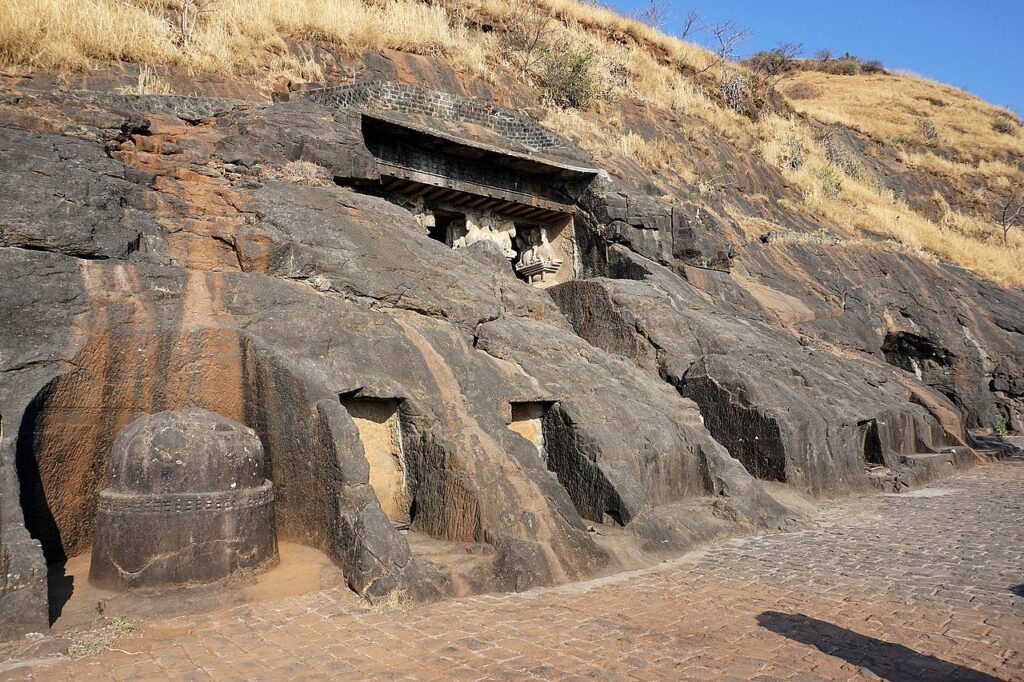
The Vihara (Monastery):
Adjacent to the prayer hall, the residential quarters consist of small cells arranged around a central courtyard. Each cell measures roughly 8 feet by 6 feet – just enough space for a monk’s sleeping mat, robes, and begging bowl.
The walls show evidence of wooden fittings that once held the monks’ few possessions. Looking closely, you can still see slots cut into the rock where wooden shelves and pegs were inserted.
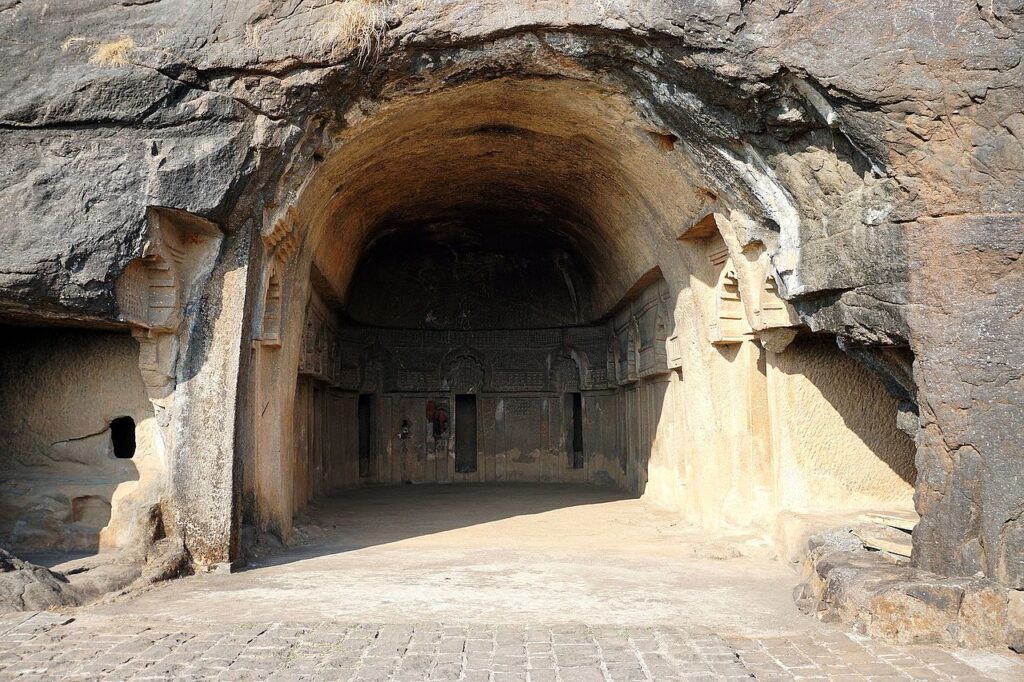
Water Management System:
One of Bedse’s most impressive features is its sophisticated water harvesting system. Large cisterns carved into the rock collected rainwater, ensuring the monastery’s survival during dry months. This engineering marvel demonstrates the practical wisdom of ancient Indian architects who understood the monsoon patterns of the region.
The Unique Pillar Carvings:
What sets Bedse apart from other Buddhist caves in Maharashtra are its distinctive pillar capitals. Each capital features a pot-shaped base supporting figures of riders – some on elephants, others on horses. Art historians believe these represent the merchant-donors who funded the caves.
The craftsmanship is remarkable. Despite being carved over 2,000 years ago, the expressions on the riders’ faces remain clearly visible. The horses’ manes flow naturally, and the elephants’ trunks curve gracefully, showing the sculptors’ deep understanding of animal anatomy.
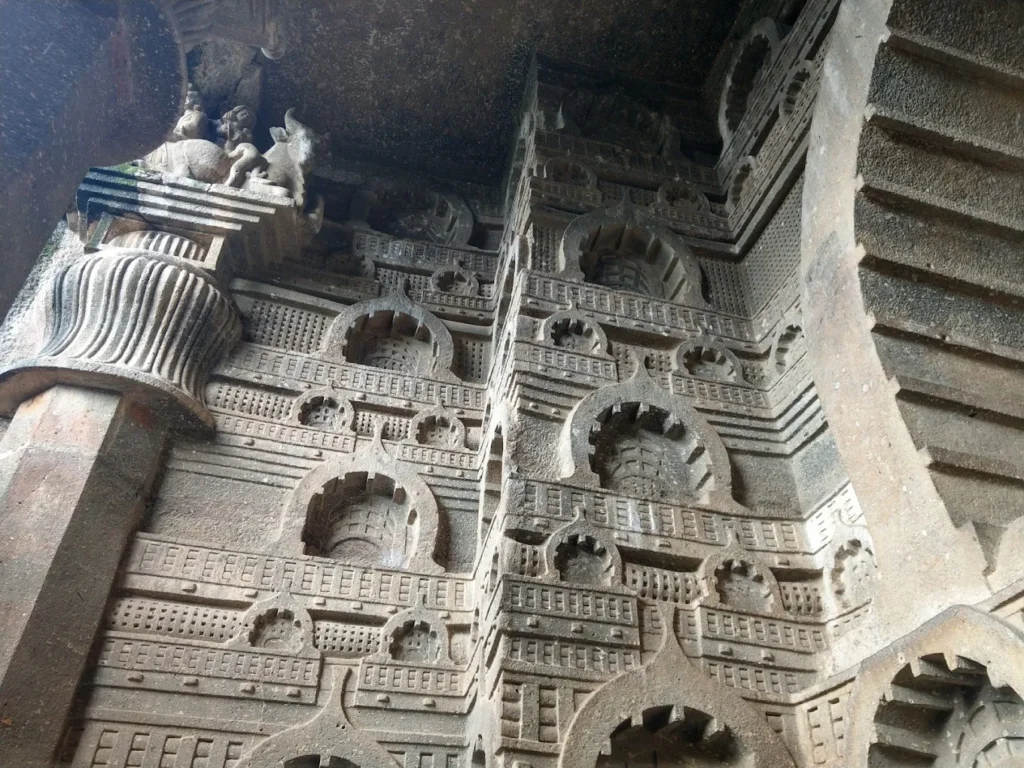
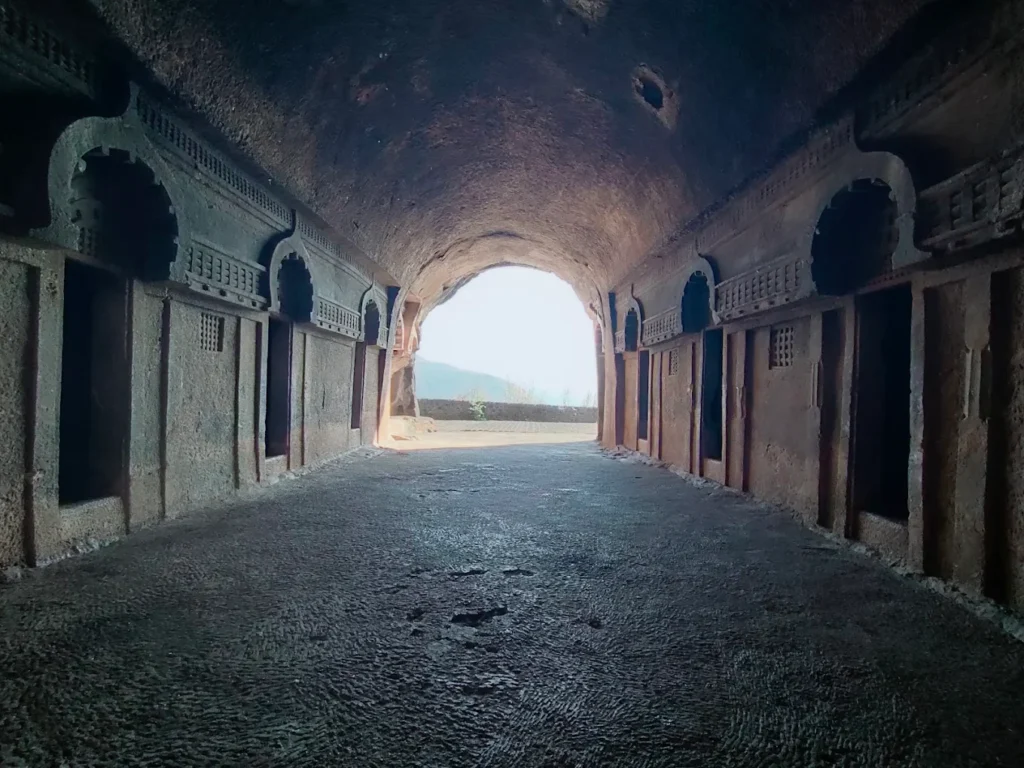
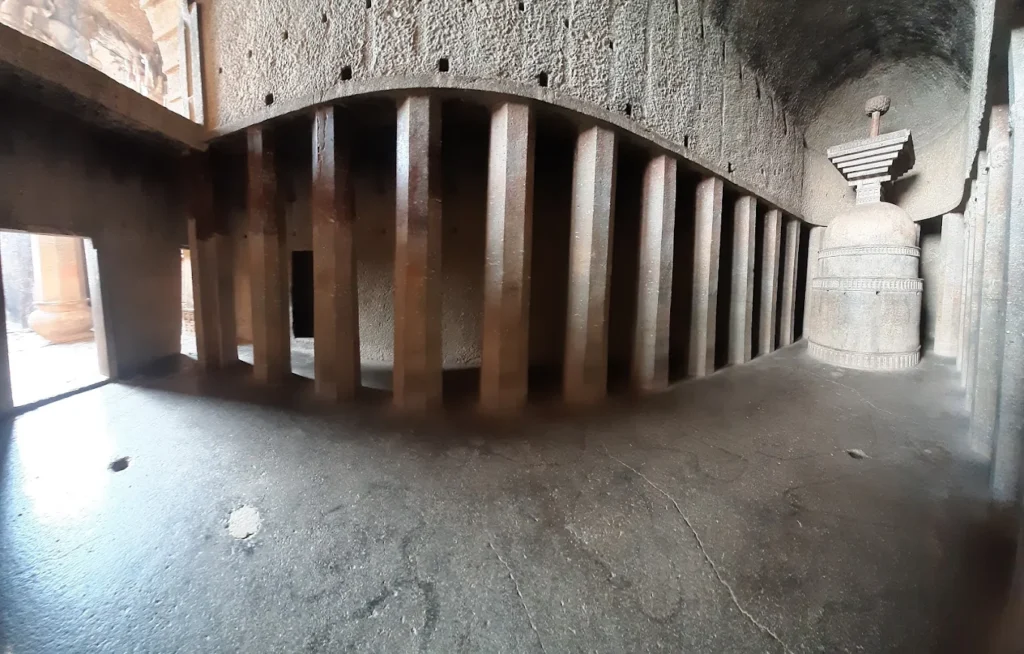
Making Your Trip Better: Practical Tips and Insights
Photography Tips for Bedse Caves
Best Lighting: Early morning light (7-9 AM) provides the most dramatic illumination of the main chaitya’s facade. The low-angle sunlight highlights the carved details while creating interesting shadows in the pillared hall.
Must-Capture Shots:
- The imposing entrance to the main chaitya, framed by carved pillars
- Close-up details of the unique rider-and-animal capitals
- The view from inside the prayer hall looking toward the stupa
- Panoramic shots of the Pawna valley from the cave entrance
- The ancient water cisterns, which showcase the engineering skills
Camera Settings: Inside the caves, you’ll need higher ISO settings (800-1600) due to limited natural light. A tripod helps for detailed shots of the carvings. For the valley views, use a polarizing filter to reduce haze and enhance the contrast between the sky and landscape.
What to Pack for Your Visit
Essential Items:
- Comfortable walking shoes with good grip (avoid sandals during monsoon)
- Water bottles (at least 1 liter per person)
- Light snacks or energy bars
- Hat and sunscreen
- Flashlight or phone torch for exploring darker cave sections
- Rain gear during monsoon season
- Camera with extra batteries
Optional but Helpful:
- Small backpack for hands-free climbing
- Wet wipes (no water facilities at the caves)
- Binoculars for bird watching and distant valley views
- Notebook for sketching the architectural details
Nearby Places to Combine Your Trip
Creating the Perfect Day Itinerary:
Morning (8:00 AM – 11:00 AM): Start at Bedse Caves when the lighting is perfect and temperatures are cool.
Late Morning (11:30 AM – 1:00 PM): Visit Karla Caves (15 km away), famous for having the largest rock-cut chaitya in India.
Afternoon (2:00 PM – 4:00 PM): Explore Bhaja Caves (20 km from Karla), known for their ancient stupas and beautiful location.
Late Afternoon (4:30 PM – 6:00 PM): End at Lohagad Fort for sunset views over the Sahyadri mountains.
Alternative Weekend Plan: Combine your cave exploration with adventure activities at Kamshet, including paragliding and hiking. The area offers several budget-friendly homestays for those wanting to spend the night.
Answering Your Questions About Bedse Caves
Frequently Asked Questions
What makes Bedse Caves different from Karla and Bhaja?
While Karla Caves impress with their massive scale and Bhaja Caves charm with their simplicity, Bedse stands out for its intricate pillar carvings and peaceful atmosphere. The rider-and-animal capitals are unique among Maharashtra’s Buddhist caves. Plus, you’ll often have the place to yourself, unlike the busier tourist sites.
Is Bedse suitable for families with children?
Yes, but with precautions. Children over 8 years old usually manage the climb well. The steps are well-defined, but supervision is essential, especially during monsoon when they become slippery. The caves themselves are safe to explore, with no dangerous drops or narrow passages.
How much time should I allocate for the visit?
Plan for 2-3 hours total: 30 minutes for the climb up, 1-1.5 hours exploring the caves and enjoying the views, and 20 minutes for the descent. Photography enthusiasts might want an extra hour.
Are guides available at Bedse Caves?
There are no official guides, but knowledgeable locals from Bedse village sometimes offer informal tours. If you’re interested in detailed historical information, consider hiring a guide in Pune or downloading a reliable archaeology app before your visit.
What’s the best way to learn more about the caves’ history during my visit?
The Archaeological Survey of India has installed some information boards, but they’re basic. For deeper insights, read about Buddhist rock-cut architecture before your visit. Books like “The Cave Temples of India” by James Fergusson provide excellent background.
Can I visit during monsoon season?
Absolutely, and many consider it the most beautiful time. The surrounding landscape becomes vibrant green, and small waterfalls appear on nearby cliffs. However, exercise extra caution on the wet steps, and be prepared for potential weather changes.
Building Trust: Our Research Sources
To ensure accuracy, the historical and architectural information in this guide is cross-referenced from authoritative sources:
- Archaeological Survey of India (ASI) – Official documentation and conservation reports on Bedse Caves
- Buddhist Architecture of Western India by S. Nagaraju – Comprehensive academic study of rock-cut monasteries
- The Cave Temples of India by James Fergusson – Foundational 19th-century archaeological surveys available on Internet Archive
- JSTOR Academic Database – Peer-reviewed articles on Buddhist art and architecture from the Journal of Indian Society of Oriental Art
- Maharashtra Tourism Development Corporation – Current visitor information and facilities
- Google Books – Indian Rock-Cut Architecture – Collection of academic texts on cave temple architecture
These sources represent decades of scholarly research and official documentation, ensuring the information in this guide meets the highest standards of accuracy and reliability. All historical claims and architectural descriptions in this article can be verified through these credible references.
Conclusion: Why Bedse Caves Deserve Your Visit
Standing inside the ancient prayer hall at Bedse Caves offers a profound connection to India’s Buddhist heritage. The elaborate pillar carvings tell stories of generous donors from over two millennia ago, while the carefully engineered water systems reveal the practical wisdom of ancient architects.
What makes Bedse special isn’t just its historical significance – it’s the complete experience. The moderately challenging climb builds anticipation, the caves themselves offer architectural marvels to explore, and the panoramic valley views provide the perfect backdrop for reflection.
Unlike more commercialized heritage sites, Bedse maintains an authentic atmosphere where you can genuinely imagine the daily lives of the monks who once called these carved chambers home. The silence is broken only by the wind through the valley and the occasional call of birds nesting in the cliff face.
Plan Your Visit Responsibly
If you decide to explore Bedse Caves, remember that you’re visiting a 2,000-year-old monument that belongs to all of humanity. Stay on designated paths, don’t touch the ancient carvings, and carry your trash back down the hill. These simple actions help preserve this incredible site for future generations.
Have you visited Bedse Caves? Share your experience and tips in the comments below – your insights could help fellow travelers make the most of their journey to this remarkable piece of ancient India.
Last Updated: September 2025 | For the latest visitor information and timings, always check the official Archaeological Survey of India website before planning your trip.
Read More Articles;
- Kaas Plateau Travel Guide 2026: Best Time to Visit, Bloom Season, How to Reach & FAQs
- What Is the Quirimbas Archipelago Mozambique Known For? Complete Travel & Nature Guide
- Is Angola Safe to Travel in 2025? Your Essential Guide to Health, Crime, and Landmine Safety
- What Animals Live in Bale Mountains Ethiopia? Complete Wildlife Guide
- What to Do in Damaraland — Complete Travel Guide for First-Timers
